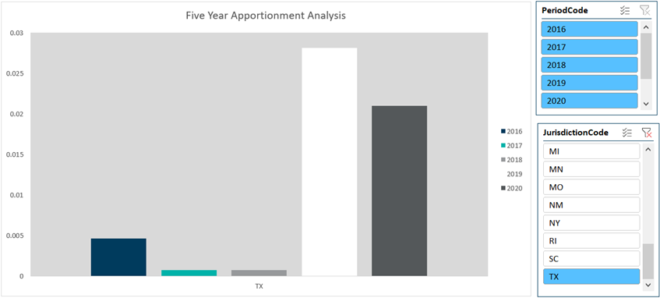Your filing deadline for state returns is looming. You’ve waited for federal numbers, weathered changing amounts, looked for dependencies across calculations, made changes to modifications, allocations, and apportionment—and ticked and tied. You’ve managed a tremendous amount of data, carryforward schedules, and rules and forms for each filing. You’ve tried to stay current with new laws and calculations for all jurisdictions. Then there’s formatting and managing numerous spreadsheets and files and re-ticking and tying—the list goes on.
You don’t have the time or tools to focus on planning, but at least you’re ready to file. That’s when you learn about hundreds of e-file errors to clear before moving forward. There must be a better way.
3 Tips to Streamline the Process – starting NOW
I understand state compliance challenges all too well from my days in public accounting and industry. Now, in my role at CSC Corptax®, I work closely with state tax teams to help them use technology to solve their pain points. Let’s take a look at what that entails:
1. Standardize
With hundreds of states and localities taking different approaches to common concepts, standardizing data sounds daunting. Yet, it’s extremely impactful. Getting to a standardized process with structured data allows you to leverage common data elements such as state modifications, apportionment data, federal data, and more—and decreases “one-offs”.
Standardizing sounds great, but how?
Work with your accounting and ERP teams to incorporate needed data points into your source data for items like apportionment. The majority of apportionment and modification data can come straight from the source. Use your tax system to automate the import of data from your source system for all jurisdictions in just one pass—netting you huge time-savings and reducing risk for errors.
Standardizing data also helps eliminate overrides. Overrides aren’t ideal: they’re frequently form-specific and can’t be recycled in other jurisdictions—much less form years. That means you can’t reuse the work you’ve done, and your work may not hold up under audit.
So, take advantage of technology that uses standard data across different jurisdictions for apportionment and modifications, such as accounts.
- Rely on your software to calculate and store apportionment factors, allocations, and modifications—no offline computing needed
- Use uniform and structured modifications based on tax jurisdiction reporting
- Use common mapping to consume data for state modifications across multiple reporting jurisdictions
2. Automate
Use automation throughout the process to streamline how you get, manage, and use state compliance data. Allowing your tax system to do more of the work reduces time spent repeating tasks, calculating data, manipulating spreadsheets, and fixing mistakes.
The illustration below shows areas automation improves state compliance.

With limited time to prepare returns, it’s imperative that state teams start with correct federal numbers to prevent mistakes and rework. The right tax system automatically updates data with real-time federal numbers—no guessing or wondering. Even last-minute federal changes flow through to state data automatically.
Compliance software lets you automate modifications based on tax law changes, as well. Take the GILTI inclusion, for instance. Your system knows which states don’t use it and will automatically decouple the GILTI inclusion for those states. That’s a lot more efficient than manually subtracting on a state-by-state basis.
3. Streamline
The best tax software incorporates new state requirements into furnished calculations and automates the calculations for you. You stay current and respond quickly and accurately when time is short. Further, you get the flexibility to change calculations for your industry using selections—not customization. And you can easily make changes to filing groups to analyze tax benefits.
Following the same methodology for all jurisdictions is another way to simplify. Use the same account across jurisdictions and let the software automatically include amounts where and when they should be included.
Concurrently doing federal and state work in one system prevents bottlenecks. You will also avoid searching for data trapped in spreadsheets or disparate systems. Instant data access gives you the ability to run hypotheticals and plan. Plus, the ability to drill down from return to source data makes it easier to analyze and review data and provide internal/external audit support.

Data Dependencies
If state work weren’t hard enough, the impact of TCJA just adds fuel to the fire. For example, chasing down how a particular state treats the outcome of federal calculations like 163(j).
The more you know about how federal changes affect state-by-state reporting, the better! Our CSC Corptax Tax Law Analysts tirelessly research and provide a matrix with detailed, federally-driven changes to state jurisdictions.
Below is a snapshot relating to 163(j) conformity, current as of 6/03/2022:
![]()
Summary
State tax plays into a company’s obligations in a big way. It pays to use off-the-shelf technological tools that streamline the process and help you mitigate the risks of incorrect or late filings, slow audit response, and interest and penalties.
If you can’t get there with your current solution, I’d be happy to show you what’s practical and possible. Reach out at 800.966.1639 or info@corptax.com.
Curran Group files hundreds of state returns using automation. Now, they have time for reviews! Learn how they do it.
about this topicAbout Carrie Ivicic
As a CSC Corptax® Sales Engineer, Carrie Ivicic works closely with the Corptax sales team and brings her extensive experience as both a customer advocate and tax technology consultant to understand and solve customer challenges. Carrie is a licensed CPA and holds a Bachelor of Arts in accounting from St. Xavier University.
